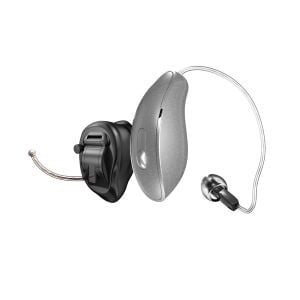
Head of Online Medical Content

Audiology Expert at Hearing Aid UK

Hearing Aids for Background Noise and Noise Reduction
How can I hear better in noise?
Overview | Deep Signal Processing | Background vs speech | Benefits | Best hearing aids for background noise | Conclusion | Chat to us
Hearing aids for background noise
Hearing aids for background noise use advanced technology to enhance speech while reducing unwanted sounds. Features like directional microphones, digital noise reduction, and machine learning algorithms help wearers focus on conversations in noisy environments. Modern devices can also adapt to changing soundscapes, improving clarity and listening comfort.
Noise-cancelling hearing aids
If you have hearing loss, you will generally have difficulty hearing in background noise. If you have hearing that is classed as 'normal' - when focusing on speech or one sound source, you can filter out the background noise automatically. People with hearing loss struggle to do this without support from hearing aids.
For example, it can be a challenge for those with hearing loss to have a conversation in a busy restaurant. This is usually why hearing in background noise is a top priority for those with hearing loss.
However, using hearing aid features and modern technology, they can distinguish and understand speech and noise. This article discusses the extra options and hearing aid features that can tackle background noise and answer the common question: How can I hear better in background noise?
Deep Signal Processing (DSP) in modern hearing aids
Wearing hearing aids helps you to distinguish the direction of sound, the source of sound and filter out the unwanted background noise - and all whilst allowing you to feel a part of your environment.
Today's hearing aid technology offers different settings and filters so that you can have full control of the way you want to hear, usually using your mobile phone hearing aid app. However, some modern hearing aids can adjust automatically.
One of the main features of modern hearing aids is background noise reduction. This smart technology is called digital signal processing or DSP. This identifies and understands background noise in the environment you're in and lowers the level of volume, resulting in better listening comfort and less listening effort.
How do hearing aids filter out background noise?
How does deep signal processing do this? The most popular way to filter out background noise is by using directional microphones, which are used to focus on sound or speech in front of you instead of behind you. A good audiologist will ask what your common environments are to customise your hearing aid settings to reflect this and support your hearing better.
They can also customise programs that enable you to tackle sporadic listening situations where there is a lot of background. But to simplify, between the two microphones within your hearing aids, you can quickly identify the direction of sound and get amplification or reduction in a certain direction.
This technology keeps improving, getting faster and more intelligent with the advancements of processing chips and more research and investment into algorithms.
Adjusting hearing aids for background noise
Because it's enough to just turn up the volume, right? Well, in short, no. Hearing aids also include volume control, but it's not used for what you might expect. For example, if you turn up the volume on your TV with your remote control, it will automatically make all sounds louder. A volume control setting on your hearing aid will turn up or down both high and low frequencies.
This ultimately makes it harder for people with hearing loss to process. For example, if you raise the volume, it can make it harder to hear your conversation, and this is because most speech is in low frequencies.
What's the difference between background noise and speech?
Hearing aids of today have very smart and powerful processors that distinguish the difference between your background noise and speech. This leaves you with better speech clarity and focus.
The main job of hearing aids is to help filter out background noise and enhance speech, making it easier for people to understand what is being said in noisy environments. This is called improved speech understanding.
What is even more impressive is that big technology doesn't have to mean big, cumbersome hearing aids anymore. Discrete, small, and invisible hearing aids incorporate this kind of technology too.
What are the benefits of improving speech understanding in background noise?
Hearing aids that help with background noise and improve speech understanding have several benefits. These are:
- It can make it easier for you to engage in conversations, both in person and over the phone.
- It can help to prevent cognitive decline.
- It can give you a better overall quality of life by making it easier for you to participate in social activities and maintain relationships.
- It can increase your self-esteem and self-confidence, which can help reduce the negative effects of hearing loss on mental health.
Who should look for hearing aids with background noise reduction?
- Those who work in noisy environments.
- Those who have an active social life.
- Those who find they are consistently struggling to hear speech in noise.

Hearing Aid to Reduce Background Noise
What is the best hearing aid for background noise?
Best hearing aids for background noise
What about the best hearing aids for background noise reduction? There are a lot of hearing aid brands that reduce background noise and improve speech understanding successfully. Each manufacturer uses different technology to tackle background noise - below are a few examples.
Phonak hearing aids for background noise
Each Phonak hearing aid has forward-facing directional microphones that share data with the other hearing aid. By working like this, they then decide from which direction sound is coming and reduce the amplification of any sound or speech that isn't coming from that direction. They call these microphones beamforming directional microphones.
►Click here to view the latest Phonak hearing aids
Oticon hearing aids for background noise
Oticon tackles background noise by segmenting and distinguishing what variations of sound you can hear using artificial intelligence, called Deep Neural Network (DNN), to give you better clarity and focus on speech.
This type of technology has been trained to understand millions of sounds of everyday life and learn. This means that the AI can correctly identify what is in your environment to then amplify and focus on what it thinks you would rather hear.
Environments like restaurants, train stations, or all the sounds you hear while walking down your street. Oticon's processor is also 50 times faster than Phonak's, scanning the environment over 100 times per second.
The result is an intelligent hearing aid that balances, organises, and prioritises the most important sounds that are unique to you, as well as supporting your own brain's cognitive health. Providing you with clear sound and speech, a deep neural network can always follow the conversation and understand sound.
►Click here to view the latest Oticon hearing aids
Resound hearing aids for background noise
Resound hearing aids reduce background noise by using their directional microphones and All Access Directionality technology. This means that one hearing aid is in a directional mode that focuses on the sound or speech coming from the direction you are looking at. The other hearing aid is in an omnidirectional mode, which enables you to still hear 360-degree sound.
The idea behind this technology is that it learns which hearing aid microphone to use as the focus, by predicting what sound or speech you want to focus on.
►Click here to view the latest Resound hearing aids
Hearing aids for noise reduction - In conclusion
Hearing aids can help reduce background noise by using advanced algorithms to filter out unwanted sounds and enhance speech. Some hearing aids also have features such as noise reduction and directional microphones that can help to further reduce background noise.
It's important to understand that the effectiveness of the noise reduction features can vary depending on the specific hearing aid, technology level, and your hearing loss. It's always best to consult with an audiologist to determine the best course of action for your specific needs.
Why Choose Us?
- FREE Hearing Tests
- Best Hearing Aids and Prices
- FREE Aftercare for Life
- FREE Home Visits
- 200+ Local Audiologists
- 60 Day Money Back Guarantee
Looking to tackle background noise better and need more support?
Can hearing aids help with background noise? Why do I struggle to hear when there is background noise?
If you would like to ask us anything surrounding this article, need additional support on hearing aids, hearing better in background noise, or looking to book a hearing test locally - call us free on
0800 567 7621
Other hearing aid advice articles you might like...
 Starkey Edge AI Hearing Aids VS Starkey Genesis AI
Starkey Edge AI Hearing Aids VS Starkey Genesis AI  Phonak Audeo Infinio VS Phonak Lumity Hearing Aids
Phonak Audeo Infinio VS Phonak Lumity Hearing Aids  What is Auracast? Is it better than Classic Bluetooth?
What is Auracast? Is it better than Classic Bluetooth? What's included in our hearing aid prices?
Our specialist service includes:
Do not spend hundreds of pounds without getting a second opinion from us.
Please call us on 0800 567 7621
 Not only are the prices great, but the service is fantastic! Many thanks to your team.
Not only are the prices great, but the service is fantastic! Many thanks to your team.Common FAQs about hearing aids for background noise
Can hearing aids help with background noise?
As well as amplifying sounds, hearing aids can filter out background noise. Most hearing aids now reduce background noise as well as help you to distinguish what sounds you can hear and from which direction they are coming from.
How do hearing aids know the difference between speech and background noise?
DSP (digital signal processing) enables the hearing aid to know the difference between background noise and speech. It does this by turning down the volume when there is no speech and up when there is within background noise.
What are the advantages of hearing aids with background noise?
Hearing aids that help with background noise and improve speech understanding have several benefits. Such as: easier conversations, less listening effort, prevents cognitive decline and increases self-esteem in social gatherings.
Other pages you might find useful
Ask the Experts
6 Morton Lane
Walkwood
Redditch
Worcestershire
B97 5QA
Latest Launch
When we refer to a product as 'Latest Launch', we mean it is the latest to be released on the market.
New
When we refer to a product as 'New', we mean that the product is the newest hearing aid model on the market.
When we refer to a product as 'Superseded', we mean that there is a newer range available which replaces and improves on this product.
Older Model
When we refer to a product as an 'Older Model', we mean that it is has been superseded by at least two more recent hearing aid ranges.
